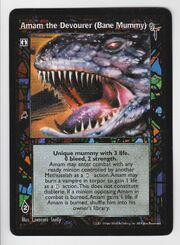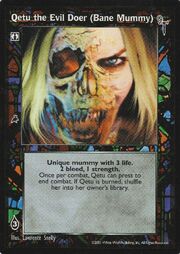Mummies, also called the Undying or Reborn, are immortals whose bodies have been ritualistically preserved, and granted the power of self resurrection. Mummy became its own distinct game line with the release of Mummy: The Resurrection in 2001 as part of the Year of the Scarab campaign push. Prior to its development and release, however, the concept of Mummy and various system iterations had gone through two previous editions. The first of these editions ostensibly was also the first new game in the World of Darkness developed and released by White Wolf Games after their first edition of Vampire the Masquerade (1991), as A World of Darkness: Mummy (1992) by Stephan Wieck was published and released prior to Werewolf: The Apocalypse (1992) later that same year. A new revised version of the game authored by Graeme Davis and James Estes was released as Mummy: Second Edition (1997), still absent broader long term game support. That kind of support of a full line didn't emerge until the re-release of the game in its third iteration of 2001.
Under Mummy: The Resurrection and later concurrent publications the scope and notion of what Mummies are and can be had much matured beyond the othering of non-Egyptian mummies as "Others" and the Orientalist tropes found in typical pop cultural fetishism with ancient Egyptian Mythos. The historical reality of mummification as a practice, and a cultural mythology around the concept of reincarnation, resurrection and the undying as being global phenomena necessitated a re-imagining of Mummies themselves. To be a Mummy had to be multinational, multicultural, multiracial in parity to them having vastly divergent histories and origins that didn't have anything to do with nor were they directly related to the timeless triangle of struggle between the Antediluvian Sutekh (Set), the ghostly Osiris, or his vengeful undying son Horus as postulated in the original iterations of the game. That story was but one Mummy's story for the Storyteller to tell, not the only one.
The most well-known mummies in the World of Darkness are the mummies of Egyptian origin, which were created by the Spell of Life. While most of these mummies were created to serve the forces of balance (Ma'at), or to enact the will of their divine patrons. the eldest of these, the Imkhu, were once the followers of Isis and Horus in Ancient Egypt. A select 42 devotees of the latter are a nominally zealous part of Horus's formal war against Set and Apophis and are referred to as the Shemsu-heru, the Followers of Horus, and supposedly adherents to the so-called Code of Horus. Not all mummies, however, were or are descended from the Egyptian Undying, nor do they all serve the region's cause, nor that of Horus himself; those like the Capacocha originated in South America, and the Wu T'ian in China are deeply engaged in their own machinations.
Known and Suspected Mummies of the Shemsu-heru[]
- Akhenaten, The Sun Pharaoh (See: VTES)
- Amen Khal (See: Mummy 1st Edition, p. 68-69)
- Cabirus (See: Mummy 2nd Edition, p. 26, 34, and the Cabiri
- Emile Tabassi, High Priest of the Cult of Isis (See: Mummy: Second Edition, p. 139-40)
- Hetch-Abehu, Vizier of North America (See: Mummy: Second Edition, p. 137-38)
- Hetephras (See: Mummy 1st Edition, p. 49-51, p. 69)
- Her-Nedi-Tef-Ef (Horus the Avenger of his Father) (See: Mummy 1st Edition, p.57-65, p. 69-70, Mummy: 2nd Edition, p. 16-21, p. 21-31, p. 120)
- Khonseru (Bacchus the Beggar) (See: Mummy 1st Edition, p. 75-
- Neferukhayt (See: Mummy: Second Edition, p. 139)
- Neith of the Shemsu-heru (See: Mummy: Second Edition, p. 121)
- Nephren-Ka (See: VTES)
- Sahu-Ra (See: Mummy 1st Edition, p. 9-11, p. 23-25, p.47-51, p. 57-63, p. 70)
- Serentu (See: Mummy 1st Edition, p. 78)
- Tchatcha-em-Onkh (See: Mummy 1st Edition, p.24-25)
- Tjehenu, The Boy Mummy (See: Mummy: Second Edition, p. 120)
- Wepauwet, the Silent Strider (See: Mummy: Second Edition, p. 69, Umbra the Velvet Shadow, Umbra Revised)
Suspected Independent Mummies[]
- Ishmael the Banished (See: Mummy 2nd Edition, p. 5, p. 25)
- Kharis the Ishmaelite (See: Mummy 2nd Edition, p. 5-7, p. 15-31, )
- Mestha the Ancient (See: Mummy 1st Edition, p. 58-63, Mummy: 2nd Edition, p. 16-21)
Known Children of Apophis - The Bane Mummies[1][]
- Amam the Devourer (See: Mummy 1st, p. 66-67 and 2nd Edition, p. 138-39) VTES)

- Tutu the Doubly Evil (See: VTES)
- Hemhemti the Roarer
- Qetu the Evil-Doer (See: VTES)

- Hau-hra of the Backward Face
- Saatatt-ta, Darkener of the Earth
- Kharebutu the Fourfold Fiend (See: VTES)
References[]
- ↑ MTR: Mummy: Second Edition, p. 28-29, p. 34-35, p. 136-37
